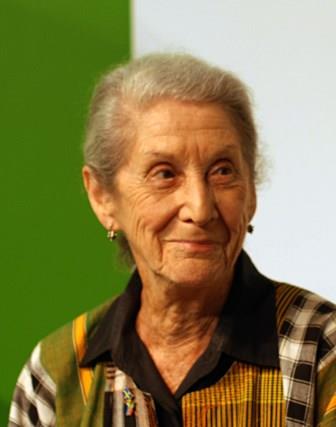
Nadine Gordimer, supporter for the reunfication of the sculptures from Parthenon, has died. The BCRPM pay tribute to this great literary writer by reflecting on her preface to Christopher Hitchen's third edition book 'The Parthenon Marbles:the case for the reunification'.
BBC Radio 4 on Frontrow also has agreat tribute to Nadine, a wonderful person and gifted writer. She wrote more than 30 books and jointly won 1974's Booker Prize for The Conservationist and was awarded the Nobel Prize for literature in 1991. Recognised as one of the literary world's most powerful voices against apartheid, she was also a firm supporter for the reunifcation of the Parthenon Marbles.
Her preface in Christopher Hitchen'sthird editon book The Parthenon Marbles:the case for the reunification which was launched in London in 2008 meant a great deal to founder of the BCRPM, Eleni Cubitt. This edition of the book is dedicated to Mrs Cubitt's husband, the late James Cubitt, a British architect that met with Melina Mercouri in the early 80's and felt very strongly about the campaign becoming as much a British concern as it was for Greece or the world.
Nadine begins her preface with:"How parts of the Parthenon frieze came to be in England in the first place is an example of imperial arrogance manifest in marble.'Wider still and wider shall thy bounds be set' - not content with claiming sovereignty over other peoples' countries, the British Empire appropriated the art in which ethos, history, religious mythology, the fundament of the people is inbued."
"Restitution now, in the twenty-first century, is on wider (appropriately) than legal grounds, grounds of dishonesty in colonialism justified as the acquisition of art."
Nadine, like Christopher and many others too could not understand why there was (including, until recently British Museumliterature) reference to these sculptures as the 'Elgin Marbles'.
"They are not and never were Lord Elgin's marbles; that is not their provenance."
Nadine was equally mistified by the British Museum's claim that as world cultural objects they are best represented in the British Museum and that in fact 'more people' can see them there.
"In terms of origin", Nadine writes," the claim is absolute: they belong to Greece."
She follows on "But as representative of the culture of ancient Greece, as the genisis of the ideal of humanism and beauty in art, there is also the argument that the Parthenon frieze belongs to world culture, to all of us who even unknowingly derive something of our democratic aesthetic from it. From that argument derives another: Where in the world should such art, universally 'owned' in the sense of human development, be displayed? The answer 'the British Museum in London' harks back to the relic of the empire, the assumption that Britain is the mecca of the world: that sections of the Parthenon frieze shown there can be seen by more people, from more parts of the globe, than is possible anywhere else."
She states that without knowing the visitor numbers of the two museums, the Acropolis Museum in Athens and the Parthenon Gallery in the British Museum - that in fact neither of these two museums are perfectly placed for the world' population to have a 'casual Sunday afternoon cultural outing.'
She concludes: "They belong: they are are the DNA, in art, of the people of Greece. They also belong, as they do, to all of us who have inherited such evidence of human creativity as development, and there is no site in our world where the direct experience of seeing them is achievable for everyone, where else should they be but where they were created?"
Nadine Gortimer also tackled that great British Museum argument of the 'floodgates'. She felt that this argument denies the purpose of art museums: 'to further appreciation of the universality in diversityof art as profound human expression, in different versions, by different peoples occupying varied environments in past and present times."
She goes on to stress 'objects complete in themselves', are not all plundered, many have been legally purchased and these would continue to be honourably retaimed by foreign museums. Nadine was determined to highlight the 'magnificent coherence', of the sculptures from the Parthenon, when they are shown in their rightful place, in Athens. She was unhappy with the British Museum's continued need to justify the retention of the sculptures in London: "as art and in its meaning as a unit, denied and destroyed".
And Nadine Gordimer concludes in her preface:"The Parthenon Gallery in the new Acropolis Museum provides a sweep of contiguous space for the 106-metre-long Panathenaic Procession as it never could be seen anywhere else in the world, facing the Parthenon itself high on the Sacred Rock." And as to the gaps in the magnificent frieze that visitors to the new Acropolis Museum see filled by the casts Greece had to buy from the British Museum..... "they are there to be filled by an honourable return of the missing parts from the British Museum. Reverence - and justice - demand this."
The British Committee for the Reunification of the Parthenon Marbles thank Nadine Gordimer for her thought provoking preface and wish her family to know that she will always be remembered as a friend, and eternally respected for her words.